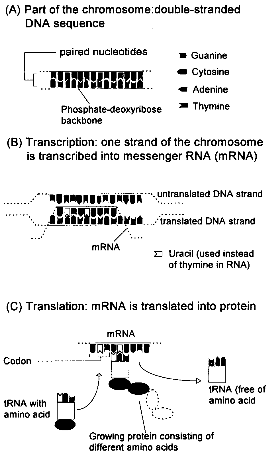|
Sie sind hier: Landwirtschaft > Transgene Pflanzen > Genet. Pflanzenschutz > Glossar  Dieser Artikel ist leider nicht in deutscher Sprache verfügbar. Dieser Artikel ist leider nicht in deutscher Sprache verfügbar. 
Appendix I: Glossary
The following glossary explains basic genetic terms frequently used in this
report. Other expressions are explained where first mentioned in the text.

Condon
A sequence of three nucleotides (see DNA) which code for an amino acid.
For example, the nucleotide sequence cytosine-adenine-guanine in mRNA codes
for the amino acid glutamine.
Constitutive
see "Expression"
DNA
Abbreviation for deoxyribonucleic acid. DNA is a genetic material of cells.
In higher orgnisms (e.g. animals and plants) is found in the nucleus of the
cells. DNA is a large linear molecule made up of the four nucleotides
adenine (A), thymine (T), guanine (G) and cytosine (C) connected by a
phosphate-deoxribose backbone. In most organisms, DNA is found as
double-stranded, helical molecules called chromosomes. The two strands of a
chromosome associate with one another by hydrogen bonds which form between
the nucleotides of one strand and the nucleotides of the other: adenine
pairs with thymine and guanine with cytosine (compare figure G.1).
Fig. G.1: From genes to proteins: A chromosome consists of two DNA
molecules which are connected by paired nucleotides (A). A gene on
one of these strands is transribed into messenger RNA (mRNA) (B). The
mRNA is then translated into a protein with the help transfer RNAs
(tRNA) which carry different amino acids (C).
Enzyme
Catalytic protein (see "Protein")
Expression
Production of the gene product. Expression rate ususally depends on
environmental and other conditions ans is regulated by promotors and
additional regulatory elements. Expression not subject to regulation is
called constitutive expression
Gene
A gene is a section of DNA specifying a messenger RNA, a ribosomal RNA, or
a transfer RNA. Messenger RNA is translated into an amino acid sequence
(a protein).
Genome
The complete set of gene present in an organism
mRNA
messenger RNA (see "RNA")
Promotor
DNA sequence which is involved in the initiation of transcription ond
therefore influences the intensity of expression of the gene product.
The promotor usually lies in the front of the DNA sequence transcribed into
a gene product.
Protein
Proteins are (sometimes very large and complex) molecules made up of 20
different amino acids. The amino acid sequence determines form and
function of the protein. Proteins either have structural (as parts of
membranes, cell walls, etc.) or catalytic functions, Catalytic proteins
are called enzymes and make possible most biochemical reactions in the
cell. An enzyme usually promotes a specific reaction or a group of
related reactions.
RNA
Abbreviation for ribonucleic acid. It is built like DNA, only that it
contains the nucleotide uracil instead of thymine and ribose instead of
deoxyribose. RNA is usually single-stranded. Messenger RNA (mRNA) is a
transcript of the DNA. It carries the information needed for the
production of proteins. Transfer RNA (tRNA) recognizes nucleotide
triplets (codons) on the mRNA and carries the corresponding amino acid
to the site of protein synthesis.
Transcription
Synthesis of a messenger RNA molecule complementary to one of the two
strands of the double-stranded DNA molecule. Compare also figure G. 1.
Transformation
Transfer of genetic information (e.g. a foreign gene) into an organism
Transgenic Term used to describe organisms containing foreign genes
inserted by using genetic engineering techniques. The foreign gene is
called transgene.
Translation
Process of translation of the codons on the messenger RNA into an amino
acid sequence (a protein). Compare also figure G. 1.
|





 Produkten.
Produkten.